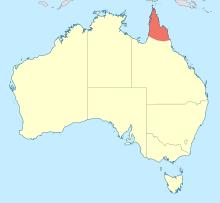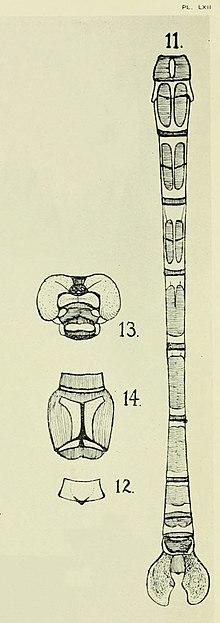| Beautiful petaltail | |
|---|---|
| Scientific classification | |
| Kingdom: | Animalia |
| Phylum: | Arthropoda |
| Class: | Insecta |
| Order: | Odonata |
| Infraorder: | Anisoptera |
| Family: | Petaluridae |
| Genus: | Petalura |
| Species: | P. pulcherrima |
| Binomial name | |
| Petalura pulcherrima | |
 | |
11. Colour pattern of abdomen
12. Inferior appendage from below
13. Colour pattern of head from in front
14. Colour pattern of thorax from above

Petalura pulcherrima is a species of Australian dragonfly in the family Petaluridae,[3] commonly known as a beautiful petaltail.[4] It is a very large and slender dragonfly, mostly black or dark brown with yellow markings and its eyes widely separated on top of its head. It has clear wings and a very long, narrow pterostigma.[4]
Petalura pulcherrima is endemic to coastal rainforests and monsoon-forest streams of Cape York in Queensland, Australia.[5] Like other species of the genus Petalura, its larvae live in burrows beside rainforest streams, with an opening above water level.[6]
Petalura pulcherrima appears similar to Petalura ingentissima which is larger still and is also found in coastal north-eastern Queensland.[4]
Petalura pulcherrima is rarely seen. The IUCN Red List considers it to be a vulnerable species, with fragmentation of its habitat by human interference a major factor.[1]
See also
- List of Odonata species of Australia
References
- ^ a b Dow, R.A. 2019. Petalura pulcherrima. The IUCN Red List of Threatened Species 2019: e.T16712A87528690. https://doi.org/10.2305/IUCN.UK.2019-2.RLTS.T16712A87528690.en. Downloaded on 26 July 2019.
- ^ Tillyard, R.J. (1912). "On some Australian Anisoptera, with descriptions of new species". Proceedings of the Linnean Society of New South Wales. 37: 582 – via Biodiversity Heritage Library.
- ^ "Species Petalura pulcherrima Tillyard, 1913". Australian Faunal Directory. Australian Biological Resources Study. 2012. Retrieved 28 January 2017.
- ^ a b c Theischinger, Günther; Hawking, John (2006). The Complete Field Guide to Dragonflies of Australia. Collingwood, Victoria, Australia: CSIRO Publishing. p. 110. ISBN 978 0 64309 073 6.
- ^ Theischinger, Gunther; Endersby, Ian (2009). Identification Guide to the Australian Odonata (PDF). Department of Environment, Climate Change and Water NSW. p. 233. ISBN 978 1 74232 475 3.
- ^ Watson, J.A.L.; Theischinger, G.; Abbey, H.M. (1991). The Australian Dragonflies: A Guide to the Identification, Distributions and Habitats of Australian Odonata. Melbourne: CSIRO. ISBN 0643051368.
